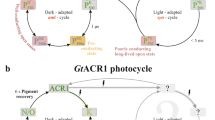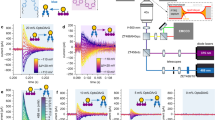Abstract
Transient receptor potential canonical (TRPC) channels TRPC3, TRPC6 and TRPC7 are able to sense the lipid messenger diacylglycerol (DAG). The DAG-sensing and lipid-gating processes in these ion channels are still unknown. To gain insights into the lipid-sensing principle, we generated a DAG photoswitch, OptoDArG, that enabled efficient control of TRPC3 by light. A structure-guided mutagenesis screen of the TRPC3 pore domain unveiled a single glycine residue behind the selectivity filter (G652) that is exposed to lipid through a subunit-joining fenestration. Exchange of G652 with larger residues altered the ability of TRPC3 to discriminate between different DAG molecules. Light-controlled activation–deactivation cycling of TRPC3 channels by an OptoDArG-mediated optical ‘lipid clamp’ identified pore domain fenestrations as pivotal elements of the channel´s lipid-sensing machinery. We provide evidence for a novel concept of lipid sensing by TRPC channels based on a lateral fenestration in the pore domain that accommodates lipid mediators to control gating.
This is a preview of subscription content, access via your institution
Access options
Access Nature and 54 other Nature Portfolio journals
Get Nature+, our best-value online-access subscription
$29.99 / 30 days
cancel any time
Subscribe to this journal
Receive 12 print issues and online access
$259.00 per year
only $21.58 per issue
Buy this article
- Purchase on Springer Link
- Instant access to full article PDF
Prices may be subject to local taxes which are calculated during checkout






Similar content being viewed by others
Change history
08 August 2018
The version of this article originally published included an extended version of the Life Sciences Reporting Summary. The error has been corrected in the HTML and PDF versions of the paper.
References
Hofmann, T. et al. Direct activation of human TRPC6 and TRPC3 channels by diacylglycerol. Nature 397, 259–263 (1999).
Bandyopadhyay, B. C. et al. Apical localization of a functional TRPC3/TRPC6-Ca2+-signaling complex in polarized epithelial cells. Role in apical Ca2+ influx. J. Biol. Chem. 280, 12908–12916 (2005).
Dietrich, A. et al. Increased vascular smooth muscle contractility in TRPC6−/− mice. Mol. Cell. Biol. 25, 6980–6989 (2005).
Neuner, S. M. et al. TRPC3 channels critically regulate hippocampal excitability and contextual fear memory. Behav. Brain Res. 281, 69–77 (2015).
Quick, K. et al. TRPC3 and TRPC6 are essential for normal mechanotransduction in subsets of sensory neurons and cochlear hair cells. Open Biol. 2, 120068 (2012).
Poteser, M. et al. PKC-dependent coupling of calcium permeation through transient receptor potential canonical 3 (TRPC3) to calcineurin signaling in HL-1 myocytes. Proc. Natl Acad. Sci. USA 108, 10556–10561 (2011).
Fuchs, B. et al. Diacylglycerol regulates acute hypoxic pulmonary vasoconstriction via TRPC6. Respir. Res. 12, 20 (2011).
Kim, M. S. et al. Genetic and pharmacologic inhibition of the Ca2+ influx channel TRPC3 protects secretory epithelia from Ca2+-dependent toxicity. Gastroenterology 140, 2107–2115.e4 (2011).
Numaga-Tomita, T. et al. TRPC3-GEF-H1 axis mediates pressure overload-induced cardiac fibrosis. Sci. Rep. 6, 39383 (2016).
Phelan, K. D., Shwe, U. T., Abramowitz, J., Birnbaumer, L. & Zheng, F. Critical role of canonical transient receptor potential channel 7 in initiation of seizures. Proc. Natl Acad. Sci. USA 111, 11533–11538 (2014).
Smedlund, K. B., Birnbaumer, L. & Vazquez, G. Increased size and cellularity of advanced atherosclerotic lesions in mice with endothelial overexpression of the human TRPC3 channel. Proc. Natl Acad. Sci. USA 112, E2201–E2206 (2015).
Spassova, M. A., Hewavitharana, T., Xu, W., Soboloff, J. & Gill, D. L. A common mechanism underlies stretch activation and receptor activation of TRPC6 channels. Proc. Natl Acad. Sci. USA 103, 16586–16591 (2006).
van Rossum, D. B. et al. TRP_2, a lipid/trafficking domain that mediates diacylglycerol-induced vesicle fusion. J. Biol. Chem. 283, 34384–34392 (2008).
Zhang, L. & Saffen, D. Muscarinic acetylcholine receptor regulation of TRP6 Ca2+ channel isoforms. Molecular structures and functional characterization. J. Biol. Chem. 276, 13331–13339 (2001).
Cao, E., Liao, M., Cheng, Y. & Julius, D. TRPV1 structures in distinct conformations reveal activation mechanisms. Nature 504, 113–118 (2013).
Gao, Y., Cao, E., Julius, D. & Cheng, Y. TRPV1 structures in nanodiscs reveal mechanisms of ligand and lipid action. Nature 534, 347–351 (2016).
Frank, J. A. et al. Photoswitchable fatty acids enable optical control of TRPV1. Nat. Commun. 6, 7118 (2015).
Frank, J. A. et al. Photoswitchable diacylglycerols enable optical control of protein kinase C. Nat. Chem. Biol. 12, 755–762 (2016).
Doleschal, B. et al. TRPC3 contributes to regulation of cardiac contractility and arrhythmogenesis by dynamic interaction with NCX1. Cardiovasc. Res. 106, 163–173 (2015).
Hofmann, T., Schaefer, M., Schultz, G. & Gudermann, T. Subunit composition of mammalian transient receptor potential channels in living cells. Proc. Natl Acad. Sci. USA 99, 7461–7466 (2002).
Lichtenegger, M. et al. A novel homology model of TRPC3 reveals allosteric coupling between gate and selectivity filter. Cell Calcium 54, 175–185 (2013).
Zagotta, W. N., Hoshi, T., Dittman, J. & Aldrich, R. W. Shaker potassium channel gating. II: transitions in the activation pathway. J. Gen. Physiol. 103, 279–319 (1994).
Mauco, G., Dangelmaier, C. A. & Smith, J. B. Inositol lipids, phosphatidate and diacylglycerol share stearoylarachidonoylglycerol as a common backbone in thrombin-stimulated human platelets. Biochem. J. 224, 933–940 (1984).
Hindenes, J.-O. et al. Physical properties of the transmembrane signal molecule, sn-1-stearoyl 2-arachidonoylglycerol. Acyl chain segregation and its biochemical implications. J. Biol. Chem. 275, 6857–6867 (2000).
Dong, Y. Y. et al. K2P channel gating mechanisms revealed by structures of TREK-2 and a complex with Prozac. Science 347, 1256–1259 (2015).
Aryal, P., Abd-Wahab, F., Bucci, G., Sansom, M. S. & Tucker, S. J. Influence of lipids on the hydrophobic barrier within the pore of the TWIK-1 K2P channel. Channels 9, 44–49 (2015).
Storch, U. et al. Dynamic NHERF interaction with TRPC4/5 proteins is required for channel gating by diacylglycerol. Proc. Natl Acad. Sci. USA 114, E37–E46 (2017).
Edgar, R. C. MUSCLE: multiple sequence alignment with high accuracy and high throughput. Nucleic Acids Res. 32, 1792–1797 (2004).
Barad, B. A. et al. EMRinger: side chain-directed model and map validation for 3D cryo-electron microscopy. Nat. Methods 12, 943–946 (2015).
Sali, A. & Blundell, T. L. Comparative protein modelling by satisfaction of spatial restraints. J. Mol. Biol. 234, 779–815 (1993).
Shen, M.-Y. & Sali, A. Statistical potential for assessment and prediction of protein structures. Protein Sci. 15, 2507–2524 (2006).
Acknowledgements
M. Lichtenegger was a fellow of the BioTechMed Graz program (project: Deciphering the lipid sensing machinery of TRPC channels); O. Tiapko, B. Svobodova and N. Shrestha are members of the PhD program (DK) “Metabolic and Cardovascular Disease” (W1226-B18). The authors wish to thank H. Janovjak for helpful discussions, M. Janschitz for assistance with graphics and T. Schmidt for critically reading the manuscript. The work was supported by FWF (P28701 and P26067 to R. Schindl., P27263 to C.R., P28243 to T.G., W1226-B18 to K.G. and SFB35 subproject F3524 to T.S.) as well as BMWFW HSRSM (PromOpt2.0 to K.G. & C.R.).
Author information
Authors and Affiliations
Contributions
M.L. and O.T. performed experiments, analyzed data and wrote parts of the manuscript; T.S. performed homology modeling; B.S., D.P., W.S., R. Schober, N.S., S.K. and R. Schindl analyzed data; T.N.G. and G.G.d.l.C. synthesized compounds; C.R. contributed with experimental planning and data interpretation; K.G. designed the project and wrote the manuscript.
Corresponding author
Ethics declarations
Competing interests
The authors declare no competing interests.
Additional information
Publisher’s note: Springer Nature remains neutral with regard to jurisdictional claims in published maps and institutional affiliations.
Rights and permissions
About this article
Cite this article
Lichtenegger, M., Tiapko, O., Svobodova, B. et al. An optically controlled probe identifies lipid-gating fenestrations within the TRPC3 channel. Nat Chem Biol 14, 396–404 (2018). https://doi.org/10.1038/s41589-018-0015-6
Received:
Accepted:
Published:
Issue Date:
DOI: https://doi.org/10.1038/s41589-018-0015-6
This article is cited by
-
Photolipid excitation triggers depolarizing optocapacitive currents and action potentials
Nature Communications (2024)
-
Ion currents through Kir potassium channels are gated by anionic lipids
Nature Communications (2022)
-
Critical contributions of pre-S1 shoulder and distal TRP box in DAG-activated TRPC6 channel by PIP2 regulation
Scientific Reports (2022)
-
Lipin-1-derived diacylglycerol activates intracellular TRPC3 which is critical for inflammatory signaling
Cellular and Molecular Life Sciences (2021)
-
Ion channels as lipid sensors: from structures to mechanisms
Nature Chemical Biology (2020)



